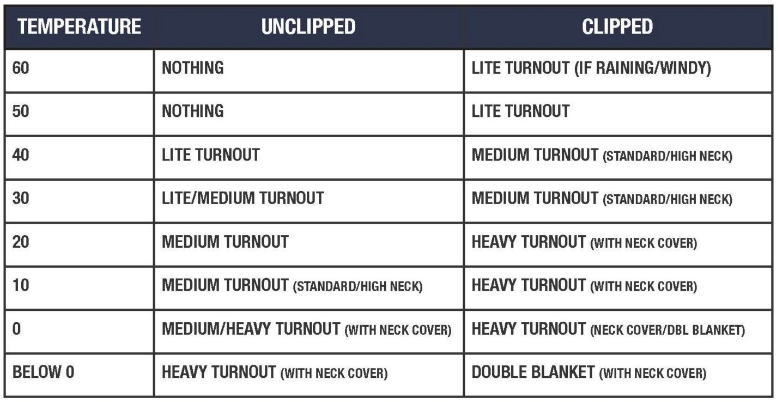To Blanket or Not To Blanket
Hair Coat – Shorter periods of daylight trigger horses to grow longer, coarser winter coats. When it gets chilly, the hairs stand on end to trap warm air close to the body, insulating the horse from the cold.
- Horses with a full winter coat are likely to be OK au naturel.
- Horses that are clipped or have sleek “show coats” will definitely need a blanket to stay warm.
Below please find a Blanketing Temperature Guide:

1. Take responsibility
Monitoring the weather and being able to make blanketing changes, or have them done for you, is just another layer of responsibility for horse owners. Of course, not all horses nor environments are created equal. Most veterinarians agree that the majority of healthy, non-clipped horses with shelter access likely do not require blanketing at all.
2. If you decide to blanket, learn to do it correctly.
Assuming that you have made the decision to blanket (or “rug”) your horse, take the time to learn more about the art of doing it correctly. There are tons of credible resources online that demonstrate how to purchase the correct size rug, what types of rug to use in varying weather conditions, etc. Your horse will appreciate every second you dedicate to ensuring a comfortable blanketing experience.
3. Proper fitting tips
A. The withers are especially sensitive and great care should be taken to ensure that the blanket sits just in front of them instead of exerting downward force on the bony wither area. Insert your hand beneath the blanket and run it gently all the way from the blanket’s chest buckles to the horse’s withers, keeping an eye out for any areas of excessive pressure; If it’s pinching your hand, then there’s no way that blanket is going to be comfortable for the horse.
B. Leg straps There seem to be a million different ways to fasten those daunting, crisscross straps that go in between our horse’s hind legs. Find the version best at keeping the blanket safely in place.
C. Last but not least, make sure both the surcingle and leg straps are neither too tight nor too loose. Drooping straps are dangerous as they may trip the horse or fail to keep the blanket in a secure position. On the other hand, overly tight straps increase the likelihood of rubbing and discomfort.
Remember: knowledge, planning and common sense are the key components to successfully blanketing (or not blanketing) your horse throughout the winter to come.